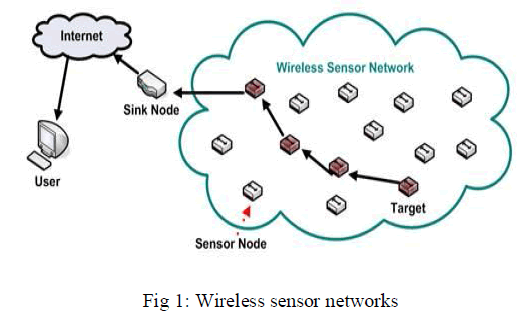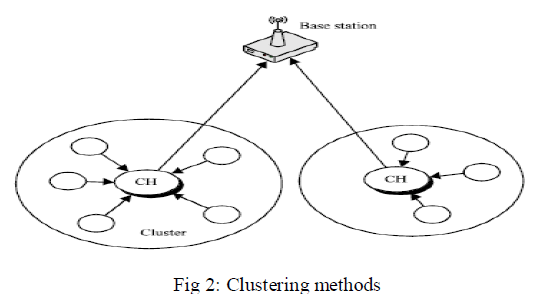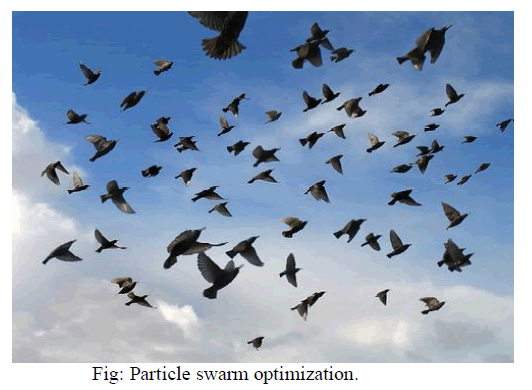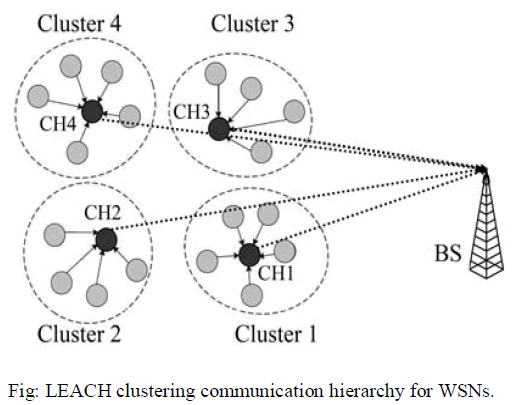ISSN ONLINE(2320-9801) PRINT (2320-9798)
ISSN ONLINE(2320-9801) PRINT (2320-9798)
K.SyedAliFathima1, T.Sumitha2
|
| Related article at Pubmed, Scholar Google |
Visit for more related articles at International Journal of Innovative Research in Computer and Communication Engineering
The major issues in wireless sensor networks is to maximize the network lifetime of sensors.The best energy efficient protocol is LEACH to reduce the energy consumption and it can extend the lifetime of wireless sensor network.Clustering techniques can be used to communicate with cluster-head and base station. If the base station is far away from the cluster-head ,energy consumption will be increased and it can reduce the lifetime of wireless sensor network.To overcome these, Paticle swarm Optimization technique is implemented with this protocol inorder to achieve maximum lifetime of wireless sensor network.PSO is used to extend the scalable and energy efficiency. It is easy to implement and the mutation calculation speed is very fast
Keywords |
| Low Energy Adaptive Clustering Hierarchy (LEACH) , Wireless Sensor Networks (WSNs) , Partical Swarm Optimization(PSO) ,Energy efficiency and Cluster methods |
INTRODUCTION |
| A wireless sensor network consists of a large number of sensor nodes and it can be used as an effective tool for collecting data from various situations. The major issue in wireless sensor networks is developing an energy-efficient routing protocol which has a significant impact on the overall lifetime of the sensor network. |
| The wireless sensor networks consist of more number of nodes and that nodes are transfer the information from source to sink or base station. The components of sensor networks are sensor nodes, sink, base station and sensor field. |
 |
| Network routing protocols are in charge of routing scheme as well as maintaining the network structure in WSNs. There are three types of network structure: flat routing, hierarchical routing and location-based routing [4]. In wireless sensor network, LEACH protocol is one of the best energy efficient protocol. It helps to reduce the energy dissipation and it is a first hierarchical based network routing protocol. Hierarchical routing is mainly considered as two layer architecture. Therefore, one layer is engaged in cluster head selection and the other layer is responsible for routing. |
| LEACH uses a clustering method to reduce the energy consumption and it arranges the nodes in network as small clusters and it select one as cluster head (CH). It provides the balancing of energy usage by random rotation of cluster heads. LEACH protocol uses a data fusion algorithm for reduce the data transmission. Cluster head are used to compress and reduce the information where received from all nodes and sends it to the sink. |
| LEACH operations are divided into two phases: |
| 1. Setup phase |
| 2. Steady phase |
 |
| In setup phase , each node is independent of other node. Then it will form cluster and cluster head(CH) is chosen for each cluster. Setup phase are used to minimize the overhead cost. During steady phase, the sensor nodes the non-cluster head nodes starts sensing data and sends it to their cluster-head according to the TDM schedule. The cluster-head node, after receiving data from all the member nodes, aggregates it and then sends it to the base-station . Steady Phase consists of Schedule Creation and Data Transmission. LEACH protocol periodically elects the cluster head nodes and re-establishes the clusters according to a round time, which ensures energy dissipation of each node in the network is relatively evenly [3]. |
OVERVIEW |
| In this section, the LEACH protocol and PSO techniques are explained. |
| LEACH PROTOCOL: |
| Wireless sensor networks is used for developing a routing protocol, has a significant impact on overall lifetime of the sensor network which employs a new technique of LEACH protocol called VLEACH.The central role is to reduce energy consumption in sensor network.LEACH performs self-organizing and re-clustering functions for every round [2][8]. Sensor nodes organize themselves into clusters in LEACH routing protocol. LEACH-E proposed to elect the cluster-heads according to the energy left in each node.[11] In every cluster one of the sensor node acts as cluster-head and remaining sensor nodes as member nodes of that cluster. Only Cluster-head can directly communicate to sink and member nodes use cluster-head as intermediate router in case of communication to sink. |
| The potential problem in current protocols is that they find the lowest energy route and use that for every communication. We propose a new protocol that we call energy aware routing. This is used to increase the survivability of networks. Additionally, these sensor nodes have limited processing power, storage and energy, while the sink nodes have powerful resources to perform any tasks or communicate with the sensor nodes.. Then we propose a heuristic routing algorithm to achieve our design goal. The algorithm works in the following way. First, we compute the network throughput, which is the most important performance metric for data-intensive computations, according to the routing on all data centre switches. The corresponding routing is called basic routing. Second, we gradually remove switches from the basic routing, until when the network throughput decreases to a predefined performance threshold. Third, switches not involved in the final routing are powered off or put into sleep mode. However, to save energy, sensor nodes send their messages to their CHs, which then aggregate the messages, and send the aggregate to the BS. However, because it is a cluster based protocol, relying fundamentally on the CHs for data aggregation and routing, attacks involving CHs are the most damaging. If an intruder manages to become a CH, it can stage attacks such as sinkhole and selective forwarding, thus disrupting the workings of the network. To overcome the disadvantages of LEACH protocol, PSO technique is employed. |
PARTICLE SWARM OPTIMIZATION (PSO): |
| Particle swarm optimization (PSO) is a simple, effective and efficient optimization algorithm. PSO is used to explore the search place. It is easy to implement and it can be applied for both scientific research and engineering use. In PSO, a global fitness function is used by all the particles in the swarm. In this, No overlapping and mutation calculation speed is very fast. It evaluates the fitness of each particle. It occupies the bigger optimization ability and it complete easily. Particles in traditional PSO represent the candidate solutions to a single optimization problem. [5]. the energy consumption and reliability are taken into an account topology control is the problem of LEACH protocol. The binary particle swarm optimization (BPSO) approach to solve the disjoint set covers (DSC) problem in the wireless sensor networks (WSN). The DSC problem is to divide the sensor nodes into different disjoint sets and schedule them to work one by one in order to save energy while at the same time meets the surveillance requirement, e.g., the full coverage objective of DSC is to maximal the number of disjoint. PSO based algorithm is used to locate the optimal sink position to the nodes to make the network is more energy efficient. |
| Some of the techniques are used to improve the network lifetime of wireless sensor network: |
| Data fusion algorithm. |
| Energy-efficient routing. |
| Locating optimal sink position. |
| PSO is more robust and easy to reach the solution for real world environmental monitoring and data aggregation problems. |
 |
ENERGY ANALYSIS |
| Energy analysis of routing protocol are as follows: |
| Sensor sends the data directly to sink. If the sink is far away, large amount of transmit power from each note will quickly drain nodes and it reduce system lifetime. By using routing protocol each node is acts as routers for other node's data in addition to sensing data. And this protocol is used to neglect energy dissipation of receiver intermediate nodes. While creating the infrastructure, the process of setting up the routes is greatly influenced by energy considerations. The multihop routing will consume less energy. So multi-hop routing introduces significant overhead for topology management and medium access control. In sometime sensors are scattered randomly over an area and multi-hop routing becomes unavoidable [13] for large area energy consumptions, Improved FZ-LEACH has been introduced. |
A.IMPROVED FZ-LEACH: |
| For large scale deployments, very small clusters does not provide energy efficiently. So, it decreases the network lifetime of wireless sensor network. The new energy efficient clustering protocol is Improved FZ-LEACH. It can eliminate the Far-Zone problem. Far-Zone is a group of sensor nodes which are placed at locations where their energies are lesser. The communication between the nodes and Sink is based on the energy consumption . The communicating nodes are in active mode and the remaining nodes will be in sleep mode, for this sleep scheduling algorithm has been used. LEACH-C each node sends their current location information and residual energy level to the sink. The Improved FZ-LEACH algorithm outperforms LEACH in terms of energy consumption and network lifetime. [12] |
| Energy efficiency is essential in some applications of wireless sensor network, especially when sensor nodes are situated in non-accessible areas like battlefield [9]. For such kind of applications solar-ware LEACH (sLEACH) has been included to maximize the lifetime of wireless sensor network through solar power. sLEACH some nodes are facilitated by solar power and these nodes will act as cluster-heads mainly depending upon their solar status. Both LEACH and LEACH-C are extended by sLEACH [6]. |
SOLAR-AWARECENTRALIZEDLEACH: |
| By using Central control algorithm, solar-aware Centralized LEACH cluster head are selected by Base station. Base station normally select solar powered nodes which have maximum residual energy. In sLEACH nodes transmit their solar status to base station along with energy and nodes with higher energy are selected as cluster-head. Performance of sensor network is increased when number of solar-aware nodes is increased. Sensor network lifetime also depends upon the sunDuration. If the sunDuration is smaller cluster-head handover is also performed in sLEACH [9]. |
| If node serving as cluster- head is running on battery and a node in cluster send data with flag, it denoted as solar power is increased, and this node will become cluster-head instead of place first its serving as cluster-head. |
CLUSTERING IN HIERRACHIAL ROUTING |
| LEACH protocol is a single-hop clustering routing protocol in wireless sensor network. Clusters in LEACH are formed dynamically and periodically, which changes interactions among the nodes and requires that any node needs to be ready to join with any CH at any time[9]. |
 |
| All nodes in the cluster transmit their data packets to CHs in specified TDMA time. TDMA-based protocols are naturally energy preserving, because time slots are built-in, and it does not suffer from collisions. The CH for each cluster receives and aggregates the data from cluster and then transmits the aggregated data to the BS. The other clustering algorithm are proposed based on LEACH, such as TEEN (Threshold Sensitive Energy Efficient Sensor Network Protocol)[4] , PEGASIS(Power Efficient Gathering in Sensor Information Systems)[5] ïüÃÅHEED(Hybrid Energy-Efficient Distributed Clustering)[6] [10]. |
A.TWO LEVEL-LOW ENERGY ADAPTIVE CLUSTERING HIERARCHY(TL-LEACH) |
| When compared to LEACH protocol, build a two-level hierarchy protocol to save better energy consumption. |
| The TL-LEACH uses random rotation of local cluster base stations (primary cluster-heads and secondary cluster-heads). [14]It uses data fusion concepts to enable a scalability and robustness. It is used to reduce the energy consumption. The primary cluster-head are used to creates a TDMA schedule assigning each node a slot to transmit. Each primary cluster-head chooses a CDMA code and informs all the nodes at second level in its group to transmit the information. |
DRAWBACKS: |
| No Guaranteeing that the cluster head nodes are distributed through the network. |
| Time duration of the set-up phase is non-deterministic and the collisions will cause the time duration too long and the sensing services are interrupted. |
| LEACH uses dynamic clustering which results in extra overhead. |
| Cluster heads used in the LEACH will consume a large amount of energy. |
CONCLUSION AND FUTUREWORK |
| In this paper, LEACH protocol is used for energy efficiency in wireless sensor network .Clustering technique is used in LEACH protocol to improve the lifetime of network .It will increase the energy but still it need some energy. In future work include Particle swarm optimization technique with LEACH protocol it provides more energy efficient to increase network lifetime of wireless sensor network. |
References |
|